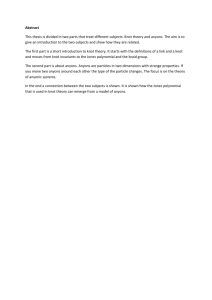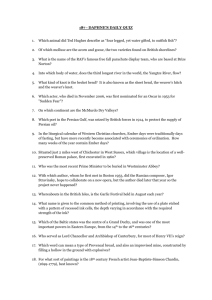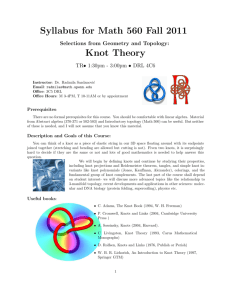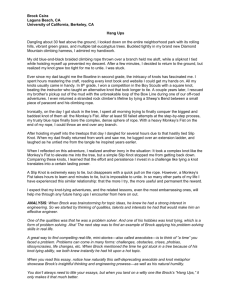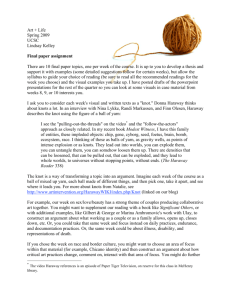Document 10463600
advertisement
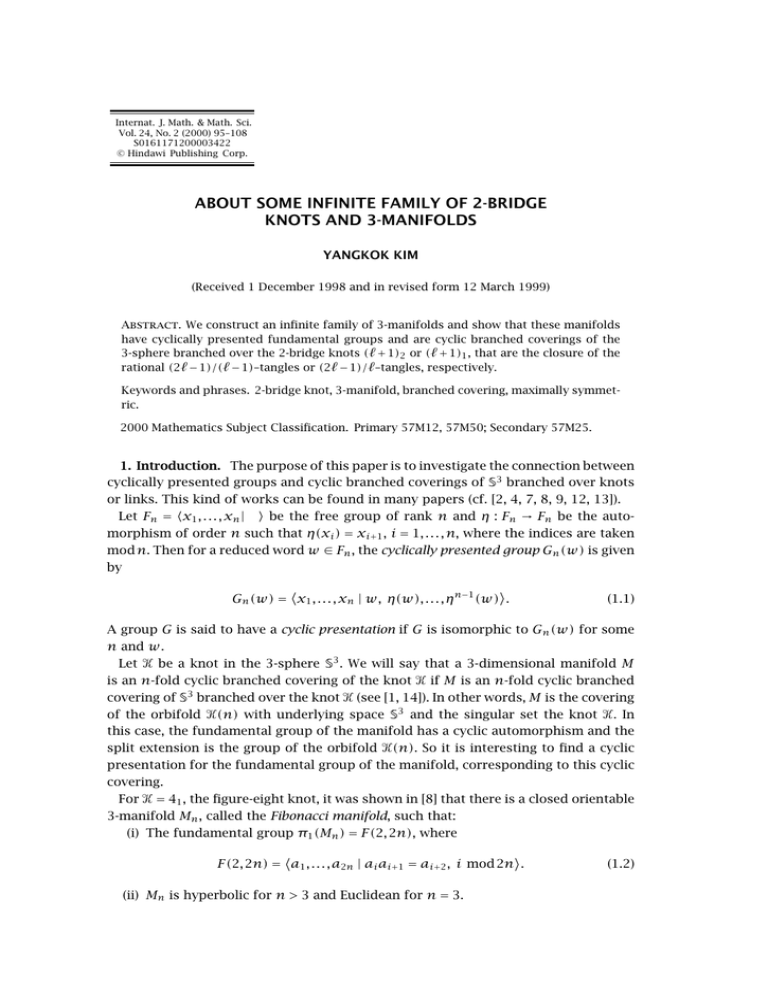
Internat. J. Math. & Math. Sci.
Vol. 24, No. 2 (2000) 95–108
S0161171200003422
© Hindawi Publishing Corp.
ABOUT SOME INFINITE FAMILY OF 2-BRIDGE
KNOTS AND 3-MANIFOLDS
YANGKOK KIM
(Received 1 December 1998 and in revised form 12 March 1999)
Abstract. We construct an infinite family of 3-manifolds and show that these manifolds
have cyclically presented fundamental groups and are cyclic branched coverings of the
3-sphere branched over the 2-bridge knots ( + 1)2 or ( + 1)1 , that are the closure of the
rational (2 − 1)/( − 1)–tangles or (2 − 1)/–tangles, respectively.
Keywords and phrases. 2-bridge knot, 3-manifold, branched covering, maximally symmetric.
2000 Mathematics Subject Classification. Primary 57M12, 57M50; Secondary 57M25.
1. Introduction. The purpose of this paper is to investigate the connection between
cyclically presented groups and cyclic branched coverings of S3 branched over knots
or links. This kind of works can be found in many papers (cf. [2, 4, 7, 8, 9, 12, 13]).
Let Fn = x1 , . . . , xn | be the free group of rank n and η : Fn → Fn be the automorphism of order n such that η(xi ) = xi+1 , i = 1, . . . , n, where the indices are taken
mod n. Then for a reduced word w ∈ Fn , the cyclically presented group Gn (w) is given
by
Gn (w) = x1 , . . . , xn | w, η(w), . . . , ηn−1 (w) .
(1.1)
A group G is said to have a cyclic presentation if G is isomorphic to Gn (w) for some
n and w.
Let be a knot in the 3-sphere S3 . We will say that a 3-dimensional manifold M
is an n-fold cyclic branched covering of the knot if M is an n-fold cyclic branched
covering of S3 branched over the knot (see [1, 14]). In other words, M is the covering
of the orbifold (n) with underlying space S3 and the singular set the knot . In
this case, the fundamental group of the manifold has a cyclic automorphism and the
split extension is the group of the orbifold (n). So it is interesting to find a cyclic
presentation for the fundamental group of the manifold, corresponding to this cyclic
covering.
For = 41 , the figure-eight knot, it was shown in [8] that there is a closed orientable
3-manifold Mn , called the Fibonacci manifold, such that:
(i) The fundamental group π1 (Mn ) = F (2, 2n), where
F (2, 2n) = a1 , . . . , a2n | ai ai+1 = ai+2 , i mod 2n .
(ii) Mn is hyperbolic for n > 3 and Euclidean for n = 3.
(1.2)
96
YANGKOK KIM
The connection between the manifolds Mn and knot theory was mentioned in [9].
Actually it was shown that
(iii) Mn is the n-fold cyclic branched covering of the knot 41 .
Hence the works for the Fibonacci manifolds constitute the most beautiful examples
of the connection between cyclically presented groups and cyclic branched coverings
of knots and links. Actually for the construction of the Fibonacci manifold Mn , a polyhedron schema was considered, that is, the boundary of 3-ball was tessellated into n
triangles in the northern hemisphere, n-triangles in the southern hemisphere, 2n triangles in the equatorial zone. Then certain orientations and identifications were considered. In this paper, we will consider more general tessellation, that is, the boundary
of 3-ball will be tessellated into n triangles in the northern hemisphere, -gons in the
southern hemisphere, n triangles and n -gons in the equatorial zone ( ≥ 3).
For ≥ 3 and n ≥ 2, let G(, n) be a finitely generated group with the following
cyclic presentation:
−2
−2
x1 , . . . , xn | xi−1 xi+1 xi−1 2 xi+1 xi−1 xi−1 2 xi−1 = 1 i mod n ,
if is even,
G(, n) =
−1
−1 −1
−1
xi 2 = 1 i mod n ,
if is odd.
x1 , . . . , xn | xi xi+1 xi 2 xi−1
(1.3)
In Section 2, we show that G(, n) can arise as a fundamental group of a closed orientable 3-manifold. In Section 3, we demonstrate that G(, n) is closely connected with
the 2-bridge knot (+1)2 or (+1)1 , that is the closure of the rational (2 − 1)/( − 1)tangle or (2 − 1)/-tangle, according as is even or odd, respectively (see [14] for notation). In Section 4, we show that the manifold obtained in Section 2 is also obtained
as a 2-fold branched covering over an n-periodic knot. Finally we will have an infinite
family of maximally symmetric manifolds in Section 5.
Remark 1.1. In particular, if = 3, all our properties are the same as the ones for
Fibonacci manifolds in [8, 9].
Remark 1.2. In the case of = 4, all the above properties were observed in [11].
2. The manifolds with their fundamental groups G(, n). We construct a 3-manifold by polyhedron description and demonstrate that G(, n) arises as a fundamental
group of a 3-manifold.
Theorem 2.1. G(, n) is a fundamental group of a 3-dimensional manifold for all
≥ 3 and all n ≥ 2.
Proof. We assume that is odd and consider a tessellation on the boundary of
3-ball, which can be regarded as a polyhedron P (, n), consisting of n triangles Fi in
the northern hemisphere, n -gons Ti in the southern hemisphere, n triangles Fi
and
n -gons Ti
in the equatorial zone. Then the polyhedron P (, n) has 4n faces, (3+)n
edges, (−1)n+2 vertices. The oriented edges can be labeled in the following manner.
97
ABOUT SOME INFINITE FAMILY OF 2-BRIDGE KNOTS . . .
N
y1
x2
y3
F3
T1
x1
y1
y2
y3
F1
x2
y1
x1
x1
T1
y1
F2
x3
F1
F3
T2
x2
y2
x2
x3
T2
y2
x2
F2
T3
x3
y3
T3
x3
x1
x1
y3
x3
x1
S
(a) The polyhedron P (5, 3).
N
y1
x2
y2
F2
T1
x2
y1
x1
y2
F1
x2
x1
y3
x1
T1
y3
y1
F2
x3
x3
F3
y2
x2
x2
T2
F3
T2
y1
x3 x2
x3
x1
x1
F1
y3
x3
T3
T3
x1
y2
x3
x1
S
(b) The polyhedron P (6, 3).
Figure 2.1.
(i) The oriented edges fall into 2n + 1 classes: xi , i = 1, . . . , n, where each class xi
consists edges, yi , i = 1, . . . , n, where each class yi consists 3 edges. In this case,
oriented edges from the same class carry the same label.
(ii) For each i = 1, . . . , n, the boundary cycle of the -gons Ti and Ti
is
−1 (−1)/2
yi+2 xi xi+1
with the indices taken mod n.
−1
(iii) For each i = 1, . . . , n, the boundary cycle of the triangles Fi and Fi
is yi xi+1 yi+1
with the indices taken mod n.
Note that the set of all the faces splits into pairs of faces with the same sequences of
oriented boundary edges. Now we identify triangles Fi with Fi
, and -gons Ti and Ti
such that the corresponding oriented edges on polygons carrying the same label are
identified for each i = 1, . . . , n. For example, if = 5 and n = 3, we have the polyhedron
P (5, 3) as shown in Figure 2.1a.
98
YANGKOK KIM
The resulting complex M(, n) has one vertex, 2n 1-cells, 2n 2-cells and one 3-cell.
Then we have a closed connected orientable 3-manifold M(, n) by applying a simple
criterion, due to Seifert and Threlfall [15]: a complex which is formed by identifying
the faces of a polyhedron will be a manifold if and only if its Euler characteristic equals
zero.
For the fundamental group of M(, n) we select N as an initial point of the closed
paths. Then we have the generating path classes of the fundamental group, Xi = xi
and Yi = yi for i = 1, . . . , n. By running around the boundaries of the 2n 2-cells of
M(, n), we get the following relators: for i = 1, . . . , n,
X i = Xi ,
Yi = Y i ,
−1 (−1)/2
Yi Xi+1
Xi
= 1,
Xi Yi−1 Yi−1 = 1.
(2.1)
Hence the fundamental group of a manifold M(, n) is
−1 (−1)/2
Xi
= 1, Yi+1 Xi Yi−1 = 1, i mod n .
X1 , . . . , Xn , Y1 , . . . , Yn | Yi Xi+1
(2.2)
Therefore it is isomorphic to G( + 1, n).
Similar arguments can be applied for the case when is even (see Figure 2.1b for
the orientation and labeling of the edges of P (6, 3)).
3. The split extension of the group G(, n)
Theorem 3.1. For ≥ 3, n ≥ 2, let K be the n-fold cyclic branched covering of the
knot ( + 1)1 if is odd and the knot ( + 1)2 if is even. Then π1 (K ) G(, n).
Proof. Let be odd. We consider a presentation for G(, n), which can be easily
−1
xi )
shown using Tieze transformation with yi (xi+1
(−1)/2
= 1 for all i = 1, . . . , n.
−1 (−1)/2
xi
= 1, xi yi−1 yi−1 = 1, i mod n .
x1 , . . . , xn , y1 , . . . , yn | yi xi+1
(3.1)
Then we see that the group G(, n) has a cyclic automorphism ρ : xi → xi+1 and
n) of group G(, n) by the
yi → yi+1 of order n. We consider the split extension G(,
cyclic group of automorphisms generated by ρ.
With notation x = x1 and y = y1 ,
−1 (−1)/2
x
= 1, xy −1 ρ −1 (y) = 1, ρ n = 1
G(,
n) = ρ, x, y | y ρ(x)
−1 (−1)/2
x
= 1, x −1 ρ = y −1 ρy, ρ n = 1 .
= ρ, x, y | y ρ(x)
(3.2)
Note that ρ and x −1 ρ are conjugate. Let µ = x −1 ρ. Then x = ρµ −1 and µ n = 1. So
(−1)/2 n
, ρ = 1, µ n = 1
G(,
n) = ρ, µ, y | ρy = yµ, y = µρ −1 µ −1 ρ
(−1)/2
(−1)/2
= (µρ −1 µ −1 ρ)
µ, ρ n = 1, µ n = 1 .
= ρ, µ | ρ µρ −1 µ −1 ρ
(3.3)
We recall that the group
(−1)/2 −1 −1 (−1)/2 = µρ µ ρ
µ
ρ, µ | ρ µρ −1 µ −1 ρ
(3.4)
99
ABOUT SOME INFINITE FAMILY OF 2-BRIDGE KNOTS . . .
µ
ρ
−1
Figure 3.1. The knot ( + 1)1 .
is the group of the knot ( +1)1 , where ρ and µ are shown in Figure 3.1 and the index
− 1 in Figure 3.1 denotes the number of half-twists.
Then the group G(,
n) is the fundamental group of the orbifold ( +1)1 (n). Hence
π1 (M(, n)) G(, n).
For the case when is even, we can apply similar arguments.
Theorem 3.2. The manifold M(, n) is the n-fold cyclic branched covering of the
knot ( + 1)1 if is odd and the knot ( + 1)2 if is even.
Proof. Rotation by 2π /n about the axis NS defines an action of Zn on M(, n).
The quotient of the action is S3 and the image of the axis NS is the knot k. The
isotropy group of a point of M(, n) not on NS is trivial. The quotient M(, n)/Zn is
obtained by taking a fundamental domain for the action of Zn on M(, n) and making
identifications (see Figure 3.2a). A Heegaard diagram for this quotient space appears
in Figure 3.2b. The thick line in Figure 3.2b is the axis NS.
N
F
N
y
F
y
F
x
x
y
T
T
y
F
y
x
x
T
S
(a)
x
x
T
S
(b)
100
YANGKOK KIM
F
F
T
N
N
S
S
T
(c)
(d)
(e)
Figure 3.2.
It lies below the diagram, inside the ball whose boundary is being identified along
the disc pairs F , F , and T , T . Cancelling handles we obtain S3 and the knot ( + 1)1
(see Figures 3.2c, 3.2d, and 3.2e).
Theorem 3.3 (Thurston). Assume q > 1. Then (p/q)(n) is hyperbolic for
(i) p = 5, n ≥ 4,
(ii) p = 5, n ≥ 3.
Moreover (p/q)(2) is spherical for all p, and (5/3)(3) is euclidean.
By Theorem 3.3 (see [5, 10]) we have that the orbifold ( + 1)1 (n) (denoted ((2 −
1)/)(n)) is hyperbolic for n ≥ 3, ≥ 3, and it is spherical for n = 2, ≥ 3.
ABOUT SOME INFINITE FAMILY OF 2-BRIDGE KNOTS . . .
101
Corollary 3.4. The manifold M(, n) is hyperbolic for all n ≥ 3 and all ≥ 3, and
M(, 2) is the lens space L(2 − 1, − 1) for even > 3 or L(2 − 1, ) for odd ≥ 3.
Corollary 3.5. The group G(, n) is infinite for all n ≥ 3 and all ≥ 3, and
G(, 2) Z2−1 .
4. The manifolds M(, n) as 2-fold coverings. In this section, we will study the
topological properties of manifolds M(, n), that gives a topological approach to
the studying of cyclically-presented groups G(, n). This study is analogous to the
topological studying of Sieradski groups S(n) and Fibonacci groups F (2, 2n) given
in [2, 3, 9, 16].
Firstly we define a series of knots. We recall that any knot can be obtained as the
p/q
we denote the
closure of some braid [1]. Let p and q be coprime integers, then by σi
rational p/q–tangle whose incoming arcs are ith and (i + 1)th strings. For an integer
the n-periodic knot which is the closure of the rational 3n ≥ 1 we denote by n
2/ n
2/(−1) n
strings braid σ2 σ1
or σ2−1 σ1
if is even or odd, respectively. The knot
4 is pictured in Figure 4.1 when is odd.
−1
2
−1
2
−1
2
−1
2
Figure 4.1. The knot 4 and is odd.
Theorem 4.1. The manifold M(, n) is the 2-fold covering of the 3-sphere branched
over the knot n
for all ≥ 3 and all n ≥ 2.
Proof. First we assume that is odd and ≥ 3. By Theorem 3.2 the manifold
M(, n) is the n-fold cyclic branched covering of the 3-sphere S3 , branched over the
knot ( +1)1 . To describe M(, n) as a 2-fold cyclic branched covering of S3 , branched
over an n-periodic knot, we will use the following construction which is analogous
to [2, 16] where the Fibonacci groups and the Sieradski groups were topologically
studied. From Figure 4.2 we see that the orbifold ( +1)1 (n) has a rotation symmetry
of order two denoted by τ such that the axe of the symmetry is disjoint from ( +1)1 .
It is not difficult to see that this symmetry action produces an orbifold ( + 1)1 /τ
with underlying space S3 and the singular set the 2-component link pictured in Figure
4.3 with branch indices 2 and n. Note that the singular set of the quotient orbifold is
102
YANGKOK KIM
τ
−1
2
−1
2
Figure 4.2. The knot ( + 1)1 with τ.
2
β̄
m+2
ᾱ
n
Figure 4.3. The singular set of ( + 1)1 /τ.
the two-component link b(4 − 2, ), that is the 2-bridge link obtained as the closure
of the rational (4 − 2)/-tangle. We will denote the quotient orbifold ( + 1)1 /τ by
b(4 − 2, )(2, n).
Then we have the following covering diagram:
n 2
M(, n) →
+ 1 2 (n) →
b 4 − 2, (2, n)
(4.1)
and a sequence of normal subgroups
G(, n) & G(,
n) & Ω(, n) = π1 b(4 − 2, )(2, n) ,
(4.2)
where |Ω(, n) : G(,
n)| = 2 and |G(,
n) : G(, n)| = n.
We describe the orbifold group Ω(, n) using the Wirtinger representation of the
link group of b(4 − 2, ) in Figure 4.3. The link group has two generators ᾱ, β̄ and
one relator of the form ᾱw = w ᾱ, where a word w is determined as follows:
w = β̄i1 ᾱi2 β̄i3 · · · ᾱi(4−4) β̄i(4−3) ,
(4.3)
and ij is the sign of the number j by mod 2(4−2) on the segment [−(4−2), 4−2].
For example, if = 5, we get a word
w = β̄ ᾱ β̄ ᾱ−1 β̄−1 ᾱ−1 β̄−1 ᾱ β̄ᾱβ̄ −1 ᾱ−1 β̄−1 ᾱ−1 β̄ ᾱ β̄.
(4.4)
ABOUT SOME INFINITE FAMILY OF 2-BRIDGE KNOTS . . .
103
In this representation the generators ᾱ and β̄ correspond to the arcs with the same
labels on the link diagram of b(4 − 2, ) in Figure 4.3.
According to [6], we get the following presentation of the orbifold group Ω(, n) of
the orbifold b(4 − 2, )(2, n):
Ω(, n) = α, β | αw = wα, αn = β2 = 1 ,
(4.5)
where the generators α and β canonically correspond to ᾱ and β̄, respectively.
Let us consider the group
Z n ⊕ Z2 = a | a n = 1 ⊕ b | b 2 = 1
(4.6)
θ : Ω(, n) → Zn ⊕ Z2
(4.7)
and the epimorphism
defined by setting θ(α) = a and θ(β) = b. By the construction of the 2-fold covering
2
( + 1)1 (n) →
b(4 − 2, )(2, n)
(4.8)
the loop β ∈ Ω(, n) lifts to a trivial loop in G(,
n). The loop α ∈ Ω(, n) lifts to a
loop in G(,
n) which generates a cyclic subgroup of order n. Thus it follows that
π1 ( + 1)1 (n) = θ −1 a | an = 1 = θ −1 (Zn ).
(4.9)
For the 2n-fold covering
2n
M(, n) →
b(4 − 2, )(2, n)
(4.10)
both loops α and β in Ω(, n) lift to trivial loops in G(, n) = π1 (M(, n)), hence
G(, n) = ker θ.
Let Γn be the subgroup of Ω(, n) given by
Γn = θ −1 b | b2 = 1 = θ −1 (Z2 ).
(4.11)
Then we get a sequence of normal subgroups
G(, n) & Γn & Ω(, n),
(4.12)
where |Ω(, n) : Γn | = n and |Γn : G(, n)| = 2. We recall, that the orbifold b(4 −
2, )(2, n) is spherical for n = 2, and hyperbolic for n ≥ 3. Hence the group Γn acts
by isometries on the universal covering Xn , that is the 3-sphere S3 for n = 2, and
the hyperbolic space H3 for n ≥ 3. Thus we get the orbifold Xn /Γn and the following
covering diagram:
2
n
M(, n) →
Xn /Γn →
b(4 − 2, )(2, n).
(4.13)
In this case, the second covering is cyclic and it is branched over the component with
index n of the singular set of b(4 − 2, )(2, n) in Figure 4.3. But this component
is the knot 1 and is trivial. So, underlying space of Xn /Γn is the 3-sphere. By the
construction of the n-fold covering
104
YANGKOK KIM
n
Xn /Γn →
b(4 − 2, )(2, n)
(4.14)
the loop α ∈ Ω(, n) lifts to a trivial loop in Γn , and the loop β ∈ Ω(, n) lifts to a loop
in Γn which generates a cyclic group of order 2. Because b(4 −2, ) are 2-bridge links
whose components are equivalent, we can exchange branch indices of components
in Figure 4.3. Therefore, the singular set of Xn /Γn is an n-periodic knot which can
2/(−1) n
be obtained as the closure of the 3-string braid σ2−1 σ1
, that is the knot n
.
Because the branch index is equal to 2, we denote Xn /Γn = n (2).
Comparing (1) and (2), we get that the following covering diagram is commutative:
M(, n)
M(, n)
n
2
kn (2)
( + 1)1 (n)
2
(4.15)
n
b(4 − 2, )(2, n)
b(4 − 2, )(2, n).
If is even, we see that the orbifold ( + 1)2 (n) has a rotation symmetry of order
two denoted by τ such that the axe of the symmetry is disjoint from the knot ( +1)2
(see Figure 4.4).
τ
−1
Figure 4.4. The knot ( + 1)2 .
Then we can apply the same arguments for odd to get the following commutative
diagram:
M(, n)
n
2
( + 1)2 (n)
2
M(, n)
b(4 − 2, − 1)(2, n)
n
(2)
n
b(4 − 2, − 1)(2, n).
(4.16)
ABOUT SOME INFINITE FAMILY OF 2-BRIDGE KNOTS . . .
105
m
σ
3
n
Figure 5.1. The singular set of θ(σ , m, n).
5. Maximally symmetric manifolds. We recall, that the maximal possible order
of a finite group G of orientation-preserving homeomorphisms of the orientable 3dimensional handlebody Vg of genus g > 1 is 12(g − 1) [17], analogous to the classical 84(g − 1)-bound for closed Riemann surfaces of genus g > 1. Let M be a closed
orientable 3-manifold. We will give the following definition according to Zimmermann
[18].
Definition 5.1. A closed orientable 3-manifold M is called maximally symmetric
if M has a Heegaard splitting of genus g > 1 and a finite group G of orientationpreserving homeomorphisms of maximal possible order 12(g − 1) which preserves
both handlebodies of the Heegaards splitting (but does not leave invariant a Heegaard
splitting of genus zero or 1).
It was shown that some of well-known 3-manifolds are maximally symmetric, for
example, the 3-sphere, the projective 3-space, the 3-torus, the Poincaré homology 3sphere and the Seifert-Weber hyperbolic dodecahedral space. It is also proven that an
irreducible maximally symmetric 3-manifold is hyperbolic or Seifert fibred.
Let us consider an orbifold with underlying space S3 whose singular set is isomorphic to the spatial graph with four vertices pictured in Figure 5.1, where σ denotes a 3-strings braid and 3, m, n are branch indices of corresponding edges with
m, n ∈ {2, 3, 4, 5} and indices of other edges are equal 2. Following [18], we denote
this orbifold by θ(σ , m, n).
We will show that the 3-manifold M(, 3) is also maximally symmetric for all ≥ 3
using the following nice criterion from [18].
Theorem 5.2 [18]. The maximally symmetric 3-manifolds (M, G) are exactly the
finite regular coverings of the orbifolds θ(σ , m, n).
Let be odd. Then the manifold M(, 3) can be obtained as a 3-fold covering of the
3-sphere branched over the knot ( + 1)1 and the orbifold ( + 1)1 (3) has a rotation
symmetry of order two denoted by τ.
106
YANGKOK KIM
σ
−1
−1
(a) The singular set of b(4 − 2, )(2, 3).
(b) The singular set of b(4 − 2, )(2, 3)/σ .
Figure 5.2.
Thus the quotient space b(4−2, )(2, 3) of the orbifold (+1)1 (3) by the involution
τ is an orbifold whose underlying space is the 3-sphere S 3 and whose singular set is
two component link b(4−2, ). Moreover b(4−2, )(2, 3) has an involution σ whose
axis intersects the singular set of b(4 − 2, )(2, 3) in four points (see Figure 5.2a).
The quotient space b(4 − 2, )(2, 3)/σ by the involution σ is an orbifold whose
underlying space is the 3-sphere S 3 and whose singular set is a spatial graph with
four vertices, pictured in Figures 5.2 and 5.3, that has one edge with branch index 3
and the other edges with branch indices 2.
−1
3
Figure 5.3. The singular set of b(4 − 2, )(2, 3)/σ .
ABOUT SOME INFINITE FAMILY OF 2-BRIDGE KNOTS . . .
107
Now we see that b(4 − 2, )(2, 3)/σ is the orbifold θ σ21− σ1 σ2−1 , 2, 2 . Thus we
have the following covering diagram:
3
2
2
( + 1)1 (3) →
b(4 − 2, )(2, 3) →
θ σ21− σ1 σ2−1 , 2, 2 .
M(, 3) →
(5.1)
For the case when is even, we can apply similar arguments.
Lemma 5.3. The manifold M(, 3) is a finite regular covering of the orbifold θ σ21−
σ1 σ2−1 , 2, 2 for all ≥ 3.
Theorem 5.4. The manifold M(, 3) is maximally symmetric for all ≥ 3.
Acknowledgement. This research was supported by the Research Foundation of
Dongeui University in 1998.
References
[1]
[2]
[3]
[4]
[5]
[6]
[7]
[8]
[9]
[10]
[11]
[12]
[13]
G. Burde and H. Zieschang, Knots, de Gruyter Studies in Mathematics, 5, Walter de Gruyter
& Co., Berlin, New York, 1985. MR 87b:57004. Zbl 568.57001.
A. Cavicchioli, F. Hegenbarth, and A. C. Kim, A geometric study of Sieradski groups, Algebra Colloq. 5 (1998), no. 2, 203–217. MR 2000b:57003. Zbl 902.57023.
A. Cavicchioli and F. Spaggiari, The classification of 3-manifolds with spines related to Fibonacci groups, Algebraic Topology, Homotopy and Group Cohomology (San Feliu
de Guixols, 1990) (Berlin), Lecture Notes in Math., vol. 1509, Springer Verlag, 1992,
pp. 50–78. MR 93m:57003. Zbl 752.57007.
W. D. Dunbar, Geometric orbifolds, Rev. Mat. Univ. Complut. Madrid 1 (1988), no. 1-3,
67–99. MR 90k:22011. Zbl 655.57008.
M. J. Dunwoody, Cyclic presentations and 3-manifolds, Groups—Korea ’94 (Pusan) (Berlin)
(A. C. Kim and D. L. Johnson, eds.), de Gruyter, 1995, Proceedings of the 3rd International Conference on the Theory of Groups held at Pusan National University,
Pusan, August 18–25, 1994, pp. 47–55. MR 98h:20067. Zbl 871.20026.
A. Haefliger and N. D. Quach, Appendice: une présentation du groupe fondamental
d’une orbifold [Appendix: Presentation of the fundamental group of an orbifold],
Astérisque (1984), no. 116, 98–107. MR 86c:57026b. Zbl 556.57032.
H. Helling, A. C. Kim, and J. L. Mennicke, Some honey-combs in hyperbolic 3-space, Comm.
Algebra 23 (1995), no. 14, 5169–5206. MR 97c:51010. Zbl 960.13339.
, A geometric study of Fibonacci groups, J. Lie Theory 8 (1998), no. 1, 1–23.
MR 99c:57005. Zbl 896.20026.
H. M. Hilden, M. T. Lozano, and J. M. Montesinos-Amilibia, The arithmeticity of the figure eight knot orbifolds, Topology ’90 (Columbus, OH, 1990) (Berlin) (B. Apanasov,
W. Neumann, A. Ried, and L. Siebenmann, eds.), Ohio State Univ. Math. Res. Publ.,
vol. 1, de Gruyter, 1992, pp. 169–183. MR 93k:57012. Zbl 767.57004.
C. Hodgson, Degeneration and regeneration of geometric structures on three-manifolds,
Ph.D. thesis, Princeton University, 1986.
G. S. Kim, Y. Kim, and A. Y. Vesnin, The knot 52 and cyclically presented groups, J. Korean
Math. Soc. 35 (1998), no. 4, 961–980. MR 99k:57002. Zbl 916.57015.
C. Maclachlan, Generalisations of Fibonacci numbers, groups and manifolds, Combinatorial and Geometric Group Theory (Edinburgh, 1993) (Cambridge) (A. J. Duncan,
N. D. Gilbert, and J. Howie, eds.), London Math. Soc. Lecture Note Ser., vol. 204,
Cambridge Univ. Press, 1995, pp. 233–238. MR 96e:20044. Zbl 851.20026.
A. Mednykh and A. Vesnin, On the Fibonacci groups, the Turk’s head links and hyperbolic
3-manifolds, Groups—Korea ’94 (Pusan) (Berlin) (A. C. Kim and D. L. Johnson, eds.),
de Gruyter, 1995, Proceedings of the 3rd International Conference on the Theory
108
YANGKOK KIM
[14]
D.
[15]
H.
[16]
A.
[17]
B.
[18]
of Groups held at Pusan National University, Pusan, August 18–25, 1994, pp. 231–
239. MR 98g:20061. Zbl 871.57001.
Rolfsen, Knots and Links, Mathematics Lecture Series, No. 7, Publish or Perish Inc.,
Berkeley, Calif., 1976. MR 58#24236. Zbl 339.55004.
Seifert and W. Threlfall, Seifert and Threlfall: A Textbook of Topology, Academic
Press Inc. [Harcourt Brace Jovanovich Publishers], New York, 1980. MR 82b:55001.
Zbl 469.55001.
Y. Vesnin and A. D. Mednykh, Fibonacci manifolds as two-sheeted coverings over a
three-dimensional sphere, and the Meyerhoff-Neumann conjecture, Sibirsk. Mat. Zh.
37 (1996), no. 3, 534–542, ii (Russian), translated in Siberian Math. J. 37 (1996), no.
3, 461–467. MR 98f:57033. Zbl 882.57011.
Zimmermann, Über Abbildungsklassen von Henkelkörpern, Arch. Math. (Basel) 33
(1979/80), no. 4, 379–382. MR 82k:57002. Zbl 416.57003.
, Hurwitz groups and finite group actions on hyperbolic 3-manifolds, J. London
Math. Soc. (2) 52 (1995), no. 1, 199–208. MR 96k:57011. Zbl 836.57009.
Yangkok Kim: Department of Mathematics, Dongeui University, 24, Kaya Dong,
Pusanjin-Ku, Pusan, 614-714, Korea
E-mail address: ykkim@hyomin.dongeui.ac.kr


